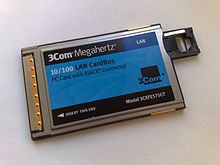PC card
| Personal Computer Memory Card International Association | |

A PC Card network adapter
|
|
| Year created | 1990 |
|---|---|
| Superseded by | ExpressCard (2003) |
| Width in bits | 32 |
| Number of devices | 1 per slot |
| Speed | 133 MB/s |
| Style | Parallel |
| Hotplugging interface | Yes |
| External interface | Yes |
In computing, PC Card is a configuration for computer parallel communication peripheral interface, designed for laptop computers. Originally introduced as PCMCIA, the PC Card standard as well as its successors like CardBus were defined and developed by the Personal Computer Memory Card International Association (PCMCIA).
It was originally designed as a standard for memory-expansion cards for computer storage. The existence of a usable general standard for notebook peripherals led to many kinds of devices being made available based on its configurability, including network cards, modems, and hard disks.
The PCMCIA 1.0 card standard was published by the Personal Computer Memory Card International Association in November 1990 and was soon adopted by more than eighty vendors. It corresponds with the Japanese JEIDA memory card 4.0 standard.
SanDisk (operating at the time as "SunDisk") launched its PCMCIA card in October 1992. The company was the first to introduce a writeable Flash RAM card for the HP 95LX (the first MS-DOS pocket computer). These cards conformed to a supplemental PCMCIA-ATA standard that allowed them to appear as more conventional IDE hard drives to the 95LX or a PC. This had the advantage of raising the upper limit on capacity to the full 32M available under DOS 3.22 on the 95LX.
It soon became clear that the PCMCIA card standard needed expansion to support "smart" I/O cards to address the emerging need for fax, modem, LAN, harddisk and floppy disk cards. It also needed interrupt facilities and hot plugging, which required the definition of new BIOS and operating system interfaces. This led to the introduction of release 2.0 of the PCMCIA standard and JEIDA 4.1 in September 1991, which saw corrections and expansion with Card Services (CS) in the PCMCIA 2.1 standard in November 1992.
Many notebooks in the 1990s had two adjacent type-II slots, which allowed installation of two type-II cards or one, double-thickness, type-III card. The cards were also used in early digital SLR cameras, such as the Kodak DCS 300 series. However, their original use as storage expansion is no longer common.
...
Wikipedia
